Logistic回归
0、读取数据
def read_dataset(filename, type_tuple, separator=','):
with open(filename) as f:
lines = f.readlines()
data = []
for line in lines:
line = line[:-1]
line = line.split(sep=separator)
row = []
for i in range(len(line)):
row.append(type_tuple[i](line[i]))
data.append(row)
return np.array(data)1、将数据进行二分类
def separate_dataset(data, col, boundary):
data0 = np.array(data)
data1 = np.array(data)
dc0, dc1 = 0, 0
for i in range(data.shape[0]):
# 为1的数据
if data[i][col] < boundary:
data1 = np.delete(data1, i-dc1, axis=0)
dc1 += 1
# 为0的数据
else:
data0 = np.delete(data0, i-dc0, axis=0)
dc0 += 1
return data0, data12、画图验证
data = read_dataset(文件路径, (float, float, float), separator=',')
data0, data1 = separate_dataset(data, -1, 0.5)
# 画图
plt.title("raw data scatter")
plt.xlabel("exam1 score")
plt.ylabel("exam2 score")
plt.scatter(data0[:, 0], data0[:, 1], marker='o', c='y', label="not admitted")
plt.scatter(data1[:, 0], data1[:, 1], marker='x', c='b', label="admitted")
plt.legend()
plt.show()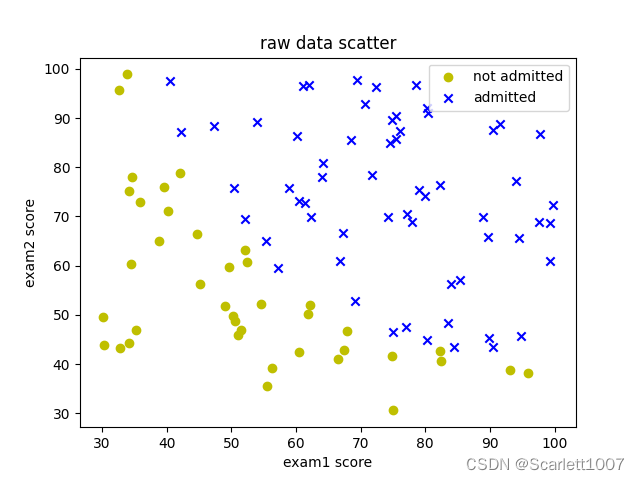
3、实现代价函数和梯度下降
def sigmoid(z):
return 1/(1+np.exp(-z))
def cost(theta, X, y):
return np.mean(-y*np.log(sigmoid(X.dot(theta)))-(1-y)*np.log(1-sigmoid(X.dot(theta))))
# 等价于
# return (-y.dot(np.log(sigmoid(X.dot(theta))))-(1-y).dot(np.log(1-sigmoid(X.dot(theta)))))/y.shape[0]
def gradient(theta, X, y):
return X.T.dot(sigmoid(X.dot(theta))-y)/y.shape[0]
def gradient_descent(X, y, theta, alpha, iterations):
for i in range(iterations):
theta -= alpha*gradient(theta, X, y)
return theta4、测试代价函数和梯度下降
# 测试代价函数, theta初始值取0
data = np.array(data)
X = np.insert(data[:, :-1], 0, 1, axis=1)
y = data[:, 2]
theta = np.zeros((3,))
print(cost(theta, X, y))
# 输出:0.6931471805599453
# 特征归一化
mean = np.mean(X[:, 1:], axis=0)
std = np.std(X[:, 1:], axis=0, ddof=1)
X[:, 1:] = (X[:, 1:]-mean)/std
# 梯度下降
alpha = 0.2
iterations = 10000
theta = gradient_descent(X, y, theta, alpha, iterations)
print("theta:", theta)
# 输出:theta: [1.71844349 4.01288964 3.74389058]
5、利用优化算法
# 使用scipy中的高级优化算法
res = opt.minimize(fun=cost, x0=theta, args=(X, y), method="TNC", jac=gradient)
theta = res.x
print("使用优化算法theta:", res.x)
# 输出:使用优化算法theta: [1.71844349 4.01288964 3.74389058]
6、画出决策边界
# 画出决策边界
x1 = np.arange(20,110,0.1)
# 进行了特征缩放,所以要还原
x2 = mean[1] - std[1] * (theta[0] + theta[1] * (x1 - mean[0]) / std[0]) / theta[2]
fig, ax = plt.subplots()
ax.plot(x1, x2, 'r', label='decision boundary')
ax.scatter(data0[:, 0], data0[:, 1], marker='o', c='y', label="not admitted")
ax.scatter(data1[:, 0], data1[:, 1], marker='x', c='b', label="admitted")
plt.legend()
plt.show()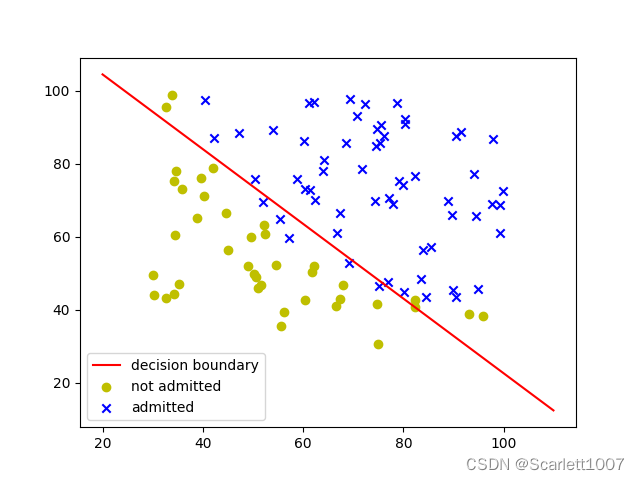
7、测试优化结果
def predict(theta, X):
return 1 if sigmoid(X.dot(theta)) > 0.6 else 0
# 如果学生exam1得分45,exam2得分85
test_s = np.array([45, 85])
test_s = (test_s - mean)/std
test_s = np.insert(test_s, 0, 1)
print(sigmoid(test_s.dot(theta)))
print(predict(theta, test_s))
# 输出:0.7762898358371403
1正则化Logistic
0、导入需要的库
import numpy as np
import matplotlib.pyplot as plt
import scipy.optimize as opt
from sklearn.metrics import classification_report1、读取数据并分类
# 读取数据
def read_dataset(filename, type_tuple, separator=','):
with open(filename) as f:
lines = f.readlines()
data = []
for line in lines:
line = line[:-1]
line = line.split(sep=separator)
row = []
for i in range(len(line)):
row.append(type_tuple[i](line[i]))
data.append(row)
return np.array(data)
# 数据分类
def separate_dataset(data, col, boundary):
data0, data1 = [], []
for i in range(data.shape[0]):
if data[i][col] < boundary:
data0.append(data[i])
else:
data1.append(data[i])
data0 = np.array(data0)
data1 = np.array(data1)
return data0, data12、画图验证
data = read_dataset(文件路径, (float, float, float), separator=',')
data0, data1 = separate_dataset(data, -1, 0.5)
# 画图
plt.title("raw data scatter")
plt.xlabel("exam1 score")
plt.ylabel("exam2 score")
plt.scatter(data0[:, 0], data0[:, 1], marker='x', c='y', label="not admitted")
plt.scatter(data1[:, 0], data1[:, 1], marker='o', c='b', label="admitted")
plt.legend()
plt.show()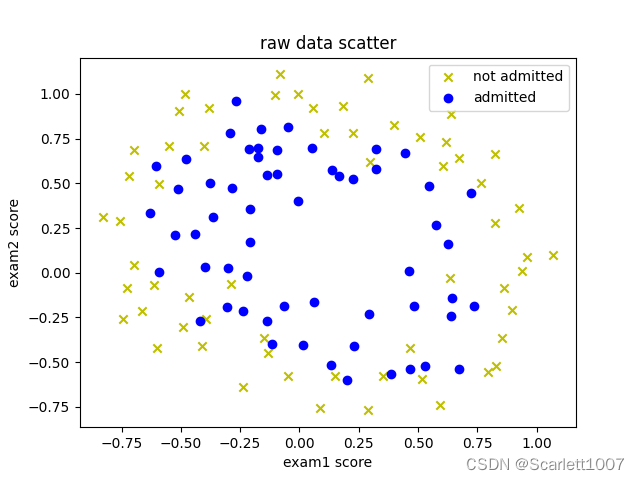
3、特征映射
# 特征映射
def features_mapping(x1, x2, power):
m = len(x1)
features = np.zeros((m, 1))
for sum_power in range(power):
for x1_power in range(sum_power+1):
x2_power = sum_power - x1_power
features = np.concatenate((features, (np.power(x1, x1_power)*np.power(x2, x2_power)).reshape(m, 1)), axis=1)
return np.delete(features, 0, axis=1)4、代价函数及梯度下降
def sigmoid(z):
return 1/(1+np.exp(-z))
def cost(theta, X, y, lamda):
m = X.shape[0]
part1 = np.mean(-y*np.log(sigmoid(X.dot(theta)))-(1-y)*np.log(1-sigmoid(X.dot(theta))))
part2 = (lamda/(2*m))*np.sum(np.delete((theta*theta), 0, axis=0))
return part1+part2
def gradient(theta, X, y, lamda):
m = X.shape[0]
part1 = X.T.dot(sigmoid(X.dot(theta))-y)/y.shape[0]
part2 = (lamda/m)*theta
return part1+part25、代入数据验证
# 特征映射
features = features_mapping(data[:, 0], data[:, 1], 6)
# 打印代价函数
y = data[:, -1]
theta = np.zeros(features.shape[-1])
print(cost(theta, features, y, 1))
#输出:0.69314718055994546、优化算法并检验预测情况
def predict(theta, X):
return [1 if i > 0.5 else 0 for i in sigmoid(X.dot(theta))]
# 优化算法
res = opt.minimize(fun=cost, x0=theta, args=(features, y, 1), method="TNC", jac=gradient)
theta1 = res.x
print(classification_report(y, predict(theta1, features)))
# 输出: precision recall f1-score support
0.0 0.85 0.77 0.81 60
1.0 0.78 0.86 0.82 58
accuracy 0.81 118
macro avg 0.82 0.81 0.81 118
weighted avg 0.82 0.81 0.81 1187、画出决策边界
x = np.linspace(-1, 1.2, 100)
x1, x2 = np.meshgrid(x, x)
z = features_mapping(x1.ravel(), x2.ravel(), 6)
z = z.dot(res.x).reshape(x1.shape)
db = plt.contour(x1, x2, z, 0, colors=['r'])
plt.title("raw data scatter")
plt.xlabel("exam1 score")
plt.ylabel("exam2 score")
plt.scatter(data0[:, 0], data0[:, 1], marker='x', c='y', label="not admitted")
plt.scatter(data1[:, 0], data1[:, 1], marker='o', c='b', label="admitted")
plt.legend()
plt.show()lamda=1时:
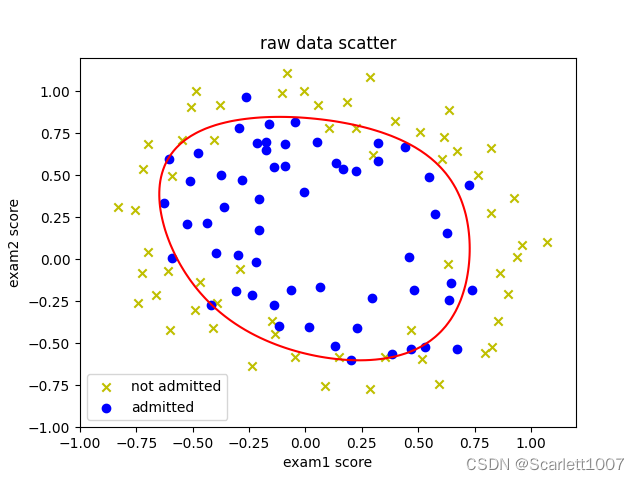
lamda=0时:
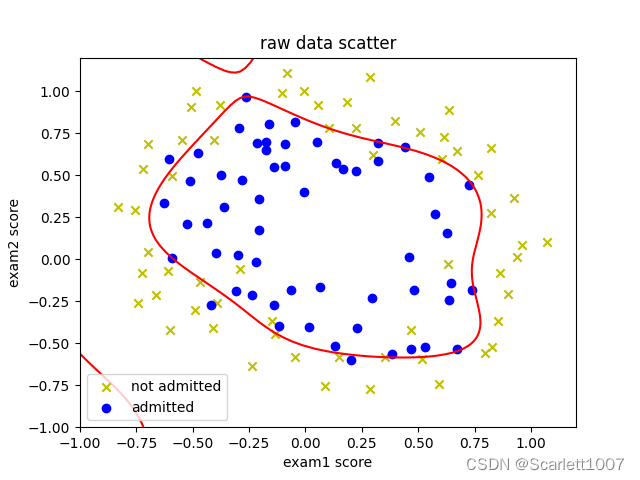
lamda=100时
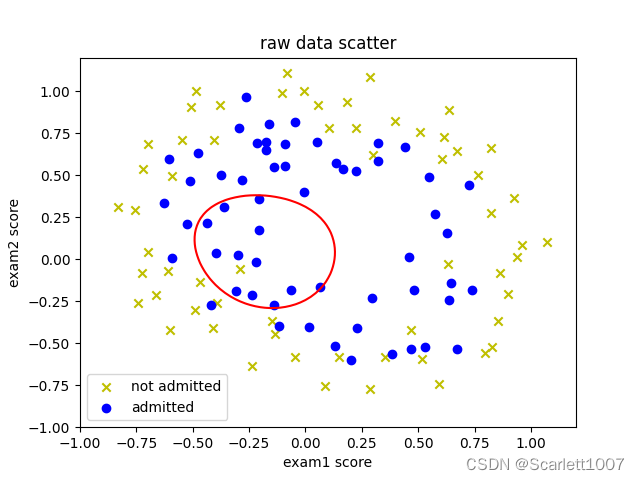
版权声明:本文为weixin_59057086原创文章,遵循 CC 4.0 BY-SA 版权协议,转载请附上原文出处链接和本声明。